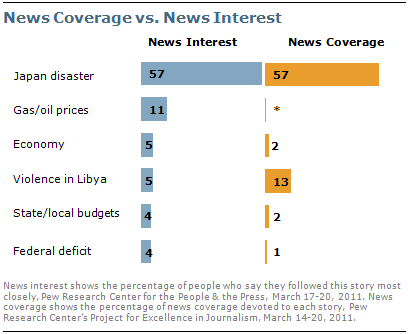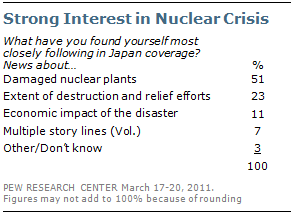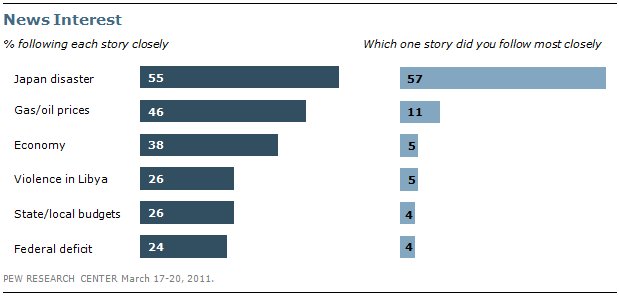Summary of Findings
 News about the aftermath of the deadly earthquake and tsunami in Japan dominated the public’s news interest and media coverage last week. The crisis at Japan’s nuclear plants – far more than other aspects of the story – captured the most public interest.
News about the aftermath of the deadly earthquake and tsunami in Japan dominated the public’s news interest and media coverage last week. The crisis at Japan’s nuclear plants – far more than other aspects of the story – captured the most public interest.
Fully 57% say they followed news about the aftermath of the March 11 earthquake and tsunami most closely last week, according to the latest News Interest Index survey conducted March 17-20 among 1,004 adults. Looking at another measure, 55% say they followed news about the catastrophe very closely. That is close to the 60% that said they very closely followed news about the earthquake in Haiti in January 2010 shortly after it struck that impoverished Caribbean nation.
News about the disaster – most of which centered on the crisis at the damaged nuclear power plants – accounted for 57% of coverage for the week, according to the Pew Research Center’s Project for Excellence in Journalism (PEJ). That makes this one of the most covered stories since PEJ started its weekly analysis four years ago. Late in the week, another major international story – preparations for and the start of a military campaign by the U.S. and allies against Moammar Gadhafi’s forces in Libya –drew heavy coverage, according to PEJ.
 Asked about which aspect of the Japan crisis they tracked most closely, 51% cite news about the damaged nuclear plants. Only 23% say they most closely followed news about the extent of the damage and relief efforts more generally and 11% say they followed news about the economic impact of the disaster most closely.
Asked about which aspect of the Japan crisis they tracked most closely, 51% cite news about the damaged nuclear plants. Only 23% say they most closely followed news about the extent of the damage and relief efforts more generally and 11% say they followed news about the economic impact of the disaster most closely.
The nuclear emergency dominated news coverage as well. Fully 71% of all coverage of the Japan disaster was devoted to the damage to the country’s nuclear facilities, according to PEJ.
Donations to Relief Efforts
In the first days after the Japanese disaster, 21% of Americans say they have made a donation to help those affected by the earthquake and tsunami. Another 24% say they plan to make a donation.
More than a third of those who have already donated (36%) say they made their contribution digitally – online, through text messages or e-mail. Among those younger than 40, about as many have donated digitally as through more traditional methods. (For more on how Americans are  using technology in donating to Japanese disaster relief, please go to the Pew Internet and American Life Project.)
using technology in donating to Japanese disaster relief, please go to the Pew Internet and American Life Project.)
Less than a week after the January 2010 earthquake in Haiti, 48% said they either had (18%) or planned (30%) to make a donation to relief efforts there. But the number who actually donated rose quickly in the weeks following the quake. By early February, more than half (52%) said they had made a donation and another 12% said they still planned to do so.
Among those who gave, donations made through traditional methods – in person, over the telephone or by mail – are still more popular than donating digitally: 11% of the public (55% of those who have made a donation) have given to the Japan relief effort through traditional means, compared with 8% (36% of those who have made a donation) who have done so digitally (on the internet, by text message or via email. The balance between donations made traditionally and digitally was similar in the immediate aftermath of the Haiti earthquake.
 Still, digital donations have grown in popularity in recent years. Six years ago, just after the deadly Indian Ocean tsunami, the balance tilted much more heavily toward traditional giving: 25% of the public said they had given by traditional means, while 4% said they had given digitally.
Still, digital donations have grown in popularity in recent years. Six years ago, just after the deadly Indian Ocean tsunami, the balance tilted much more heavily toward traditional giving: 25% of the public said they had given by traditional means, while 4% said they had given digitally.
The change is most striking among younger people. Currently, those under 40 are just as likely to say they donated through traditional or digital means (12% each). Following the Indian Ocean tsunami, 20% said they had donated traditionally, while 5% said they had donated digitally.
The Week’s News
With most public and media attention focused on the aftermath of the disaster in Japan, Americans showed only modest interest in other news stories last week. Interest in Japan news was high across demographic and partisan groups. Half or more in every region say they followed this news very closely.
With most of the survey completed before airstrikes on Libya were launched by U.S. and allied forces, public interest in developments in Libya remained modest. About a quarter (26%) say they followed the conflict between rebels and government forces there very closely; 5% say this was the news they followed most closely. News about unrest in the Middle East accounted for 17% of coverage. Most of that (13%) focused on Libya.

The public continued to closely track economy news. Nearly half (46%) say they very closely followed news about the rising price of gas and oil. Nearly four-in-ten (38%) say they very closely followed news about the economy.
Interest in news about fuel prices is especially strong among those with lower incomes. Fully 52% of those with annual family incomes of less than $30,000 say they followed this story very closely, compared with 39% of those with incomes of $75,000 or more. Among those with family incomes of $30,000 to $74,999, 45% followed gas price news very closely.
Few, though, say they followed either news about fuel prices or the economy in general more closely than any other news last week. About one-in-ten (11%) say they followed oil and gas price news most closely and 5% say they followed economic news most closely. News about gas prices and the economy more generally received little coverage.
About a quarter (26%) say they followed news about state and local budget problems very closely. Just 4% say this was the news they followed most closely. Comparable numbers say they followed news about the debate over the federal budget deficit closely (24% very closely, 4% most closely). Neither story accounted for more than 2% of coverage measured by PEJ.
These findings are based on the most recent installment of the weekly News Interest Index, an ongoing project of the Pew Research Center for the People & the Press. The index, building on the Center’s longstanding research into public attentiveness to major news stories, examines news interest as it relates to the news media’s coverage. The weekly survey is conducted in conjunction with The Project for Excellence in Journalism’s News Coverage Index, which monitors the news reported by major newspaper, television, radio and online news outlets on an ongoing basis. In the most recent week, data relating to news coverage were collected March 14-20, and survey data measuring public interest in the top news stories of the week were collected March 17-20, from a nationally representative sample of 1,004 adults.
About the News Interest Index
The News Interest Index is a weekly survey conducted by the Pew Research Center for the People & the Press aimed at gauging the public’s interest in and reaction to major news events. This project has been undertaken in conjunction with the Project for Excellence in Journalism’s News Coverage Index, an ongoing content analysis of the news. The News Coverage Index catalogues the news from top news organizations across five major sectors of the media: newspapers, network television, cable television, radio and the internet. Each week (from Monday through Sunday) PEJ compiles this data to identify the top stories for the week. (For more information about the Project for Excellence in Journalism’s News Coverage Index, go to www.pewresearch.org/journalism.) The News Interest Index survey collects data from Thursday through Sunday to gauge public interest in the most covered stories of the week.
Results for this survey are based on telephone interviews conducted March 17-20 among a national sample of 1,004 adults 18 years of age or older living in the continental United States (673 respondents were interviewed on a landline telephone, and 331 were interviewed on a cell phone, including 144 who had no landline telephone). The survey was conducted by interviewers at Princeton Data Source under the direction of Princeton Survey Research Associates International. A combination of landline and cell phone random digit dial samples were used; both samples were provided by Survey Sampling International. Interviews were conducted in English. Respondents in the landline sample were selected by randomly asking for the youngest adult male or female who is now at home. Interviews in the cell sample were conducted with the person who answered the phone, if that person was an adult 18 years of age or older.
The combined landline and cell phone sample are weighted using an iterative technique that matches gender, age, education, race, Hispanic origin, region, and population density to parameters from the March 2010 Census Bureau’s Current Population Survey. The sample is also weighted to match current patterns of telephone status based on extrapolations from the 2010 National Health Interview Survey. The weighting procedure also accounts for the fact that respondents with both landline and cell phones have a greater probability of being included in the combined sample and adjusts for household size within the landline sample. Sampling errors and statistical tests of significance take into account the effect of weighting. The following table shows the sample sizes and the error attributable to sampling that would be expected at the 95% level of confidence for different groups in the survey:

Sample sizes and sampling errors for other subgroups are available upon request.
In addition to sampling error, one should bear in mind that question wording and practical difficulties in conducting surveys can introduce error or bias into the findings of opinion polls.


